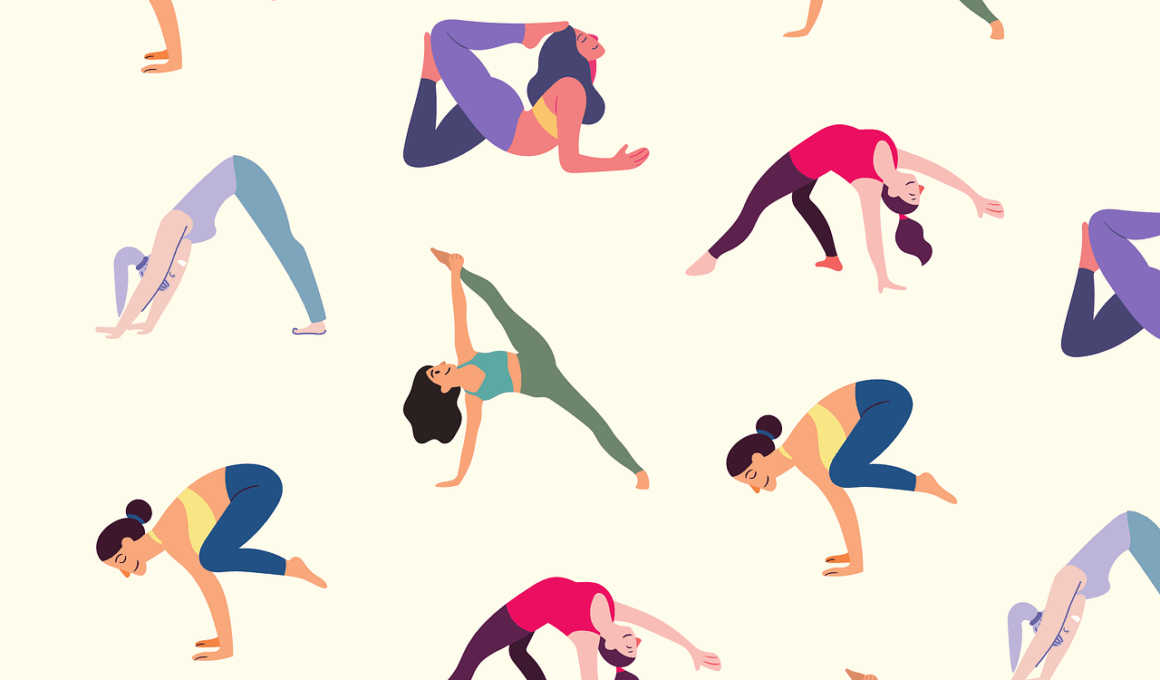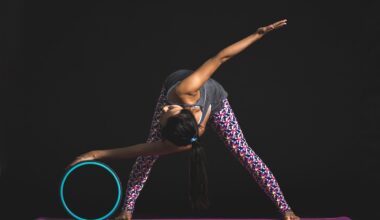Pilates and Proprioception: Enhancing Body Control
Pilates is not only about creating muscular strength but also enhancing proprioception, which is the sense of body position and movement. This practice promotes a deeper awareness of one’s body in space. Through its controlled movements, Pilates emphasizes the connection between mind and body, allowing practitioners to develop a more profound understanding of how their bodies move. An improvement in proprioception leads to better coordination, balance, and overall physical awareness. Thus, incorporating Pilates into a fitness routine can serve as a foundational approach to enhancing body control. The method encourages engagement of both core stability and peripheral coordination, resulting in an increase in functional movement. Additionally, through focused breathing and specific exercises, individuals learn to stabilize their pelvis and spine, which is crucial for better posture. As you become more attuned to your body’s signals, you can more easily identify imbalances or weaknesses. Overall, Pilates is an effective way to refine proprioceptive skills, which translates into improved athletic performance and daily functional movements. Moreover, as you progress in your practice, you might observe how these enhancements impact your daily activities positively.
Through various exercises, Pilates invites practitioners to explore their sensory awareness while strengthening the body. Balance and coordination are vital components in the realm of fitness, as they contribute to overall athleticism. In Pilates classes, you’ll often engage in exercises that challenge your stability while targeting your core muscles. For example, movements such as the “Single Leg Stretch” and “The Teaser” not only work on muscle endurance but also require active engagement of your proprioceptive senses. In doing so, individuals learn to control their body movements more effectively, making it easier to execute and transition between various positions seamlessly. When balance is improved, it becomes easier to engage in more challenging physical activities. Pilates emphasizes the importance of alignment, which greatly aids in refining both balance and coordination. The method also incorporates the use of props like stability balls and resistance bands, enhancing the experience further. By providing additional support or instability, these props allow practitioners to increase or decrease the difficulty of movements, helping to hone the skills required for effective coordination. Ultimately, this approach successfully illustrates the connection between physical strength and sophisticated body control.
One of the key elements of Pilates for enhancing coordination is the emphasis on integrating breath with movement. By synchronizing breath with physical actions, practitioners can develop an essential rhythm that fosters improved body awareness. For instance, inhaling during preparation and exhaling during the exertion phase of an exercise allows for greater control and precision. This breathing technique is fundamental to executing Pilates movements correctly. It also helps in building internal focus, which plays a crucial role in proprioception. During sessions, you’ll often find yourself extending this breath pattern beyond the mat, creating a mindful approach applicable to other physical pursuits. As you breathe consciously, you will notice how it informs your movements and helps maintain stability, particularly when transitioning between exercises. Such heightened awareness can lead to noticeable improvements in athletic performance as well. Moreover, Pilates teaches how to stabilize one’s center, effectively enabling better weight distribution. As a result, advanced movement patterns become more attainable, further enhancing overall coordination and balance. This ability to remain balanced while in motion contributes to a more dynamic athletic experience, which can positively affect a person’s active lifestyle.
The Role of Core Strength in Stability
At the heart of Pilates lies the focus on core strength, serving as an anchor to overall coordination and balance. A strong core enhances stability, allowing practitioners to perform complex movements with greater ease. This stability is not just about the abdominal muscles; it encompasses the pelvis, spine, and surrounding structures. By cultivating core strength through targeted exercises, one can reduce the risk of injury and improve athletic performance. During Pilates sessions, exercises like the “Plank” and “Bridge” activate these essential muscle groups, leading to better support for the spine and pelvis during dynamic movements. As you become more stable, you will notice that your overall body control improves significantly. The enhanced core stability also encourages proper alignment throughout all activities, whether on the mat or in daily life. Additionally, a stronger core translates into improved endurance, as these muscles engage while performing various movements. This ability to hold positions longer enhances one’s ability to complete complex sequences smoothly. Consequently, incorporating core-focused Pilates exercises into your routine is a strategic approach to improving your balance and coordination effectively.
Furthermore, Pilates is adaptable, and individuals of all fitness levels can benefit from its principles. Whether you are an athlete looking to refine your skills or a beginner aiming to enhance overall coordination, Pilates offers a range of exercises tailored to fit your needs. The beauty of this practice lies in its versatility, providing modifications and progressions that ensure everyone can engage with the benefits effectively. Instructors often adapt exercises based on individual requirements, allowing for personal progression aligned with each participant’s comfort level and experience. This customizability fosters a supportive environment where students can focus on their proprioceptive skills and enhance coordination in a non-intimidating manner. Additionally, group classes create a sense of community and shared motivation, which can further inspire participants to challenge themselves. As coordination improves through consistent practice, participants often feel empowered, paving the way for further fitness exploration beyond Pilates. Ultimately, this approachable aspect promotes longevity in one’s fitness journey, encouraging diverse means of obtaining physical fitness through an awareness-based approach to bodily control. Sustained engagement in practice will continually reinforce coordination and balance improvements over time.
Incorporating Pilates exercises into a broader fitness regimen also enhances proprioceptive training. Cross-training with Pilates allows athletes to not only maintain existing skills but to elevate their game further. The mindful practice of Pilates can directly influence performance in various sports by enhancing core stability, flexibility, and body awareness. For instance, runners may find that adding Pilates routines assists in improving posture and stride efficiency, while dancers may notice increased body control when executing challenging choreography. The adaptability of Pilates means it can provide benefits to virtually any athletic endeavor. Moreover, recent studies have indicated that proprioception and body control are crucial for injury prevention. Specifically, enhancing these qualities through focused exercise can aid in reducing risk by increasing functional movement capabilities. As such, those involved in high-impact sports or activities requiring agility often benefit significantly from incorporating Pilates into their training. This blend fosters a holistic approach to physical fitness, encompassing strength, flexibility, and coordination. Stretching and strength elements of Pilates offer an effective way to engage the body in a manner that promotes longevity in sports performance while supporting overall wellness.
In conclusion, Pilates philosophy is deeply intertwined with enhancing proprioception and body control. Through consistent practice, practitioners build a heightened awareness of their body, which contributes to improved balance and coordination. The integration of breath, core strength, and mindful movement facilitates an environment conducive to growth, allowing individuals to experience significant benefits in both fitness and daily life. As coordination skills develop, other physical activities become more accessible, resulting in increased confidence and motivation to pursue new goals. Moreover, the focus on alignment and stability ensures that practitioners can engage in their desired sports with greater safety and effectiveness. Additionally, the adaptable nature of Pilates makes it an excellent complement to various athletic pursuits, promoting a well-rounded approach to fitness. By fostering connections within the body, Pilates empowers individuals to excel across multiple domains. Ultimately, the practice offers invaluable tools for enhancing proprioception, enabling better physical performance and supporting overall wellness. Engaging in Pilates not only leads to improved movement quality but enriches the journey of mastering one’s body. This journey of self-awareness and growth continues as one interacts with Pilates, enhancing overall well-being.
A shared bond exists between the commitment to practising Pilates and recognizing its significance in enhancing proprioception. Many Pilates enthusiasts realize that the ongoing journey toward greater body awareness and control greatly shapes personal fitness goals. By emphasizing proper alignment, breathing techniques, and intentional movement, Pilates creates a solid foundation for improving overall body coordination. Even small adjustments in posture and positioning can lead to impactful changes during workouts. Regular practice allows for gradual refinement, promoting muscular balance and reducing the potential for injury. Increased proprioceptive awareness leads to active engagement of stabilizing muscles, which are foundational for effective movement in everyday activities. As balance improves, participants typically experience more fluidity in their transitions between exercises, allowing for a seamless experience. Additionally, enhanced proprioception can lead to greater confidence when trying new movements or modifying existing exercises. Engaging with these principles enriches self-discovery, giving individuals insight into their bodies and movement habits. Ultimately, the fusion of Pilates with proprioception offers a transformative experience, guiding individuals toward a deeper understanding of their physical capabilities. Each session unfolds opportunities for progress and awareness, emphasizing the importance of ongoing commitment to one’s wellness journey.


